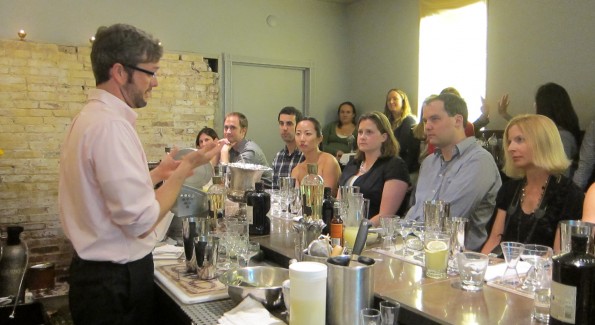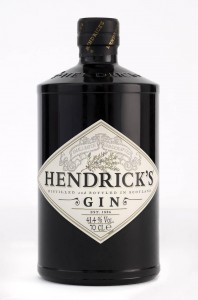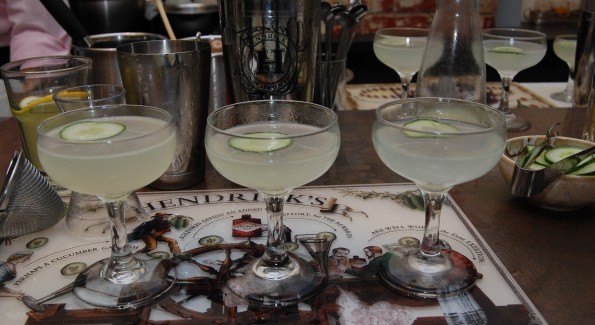Deconstructing and reinventing a classic cocktail bridges the gin-eration gap.
By Kelly A. Magyarics
Since its release a few years ago, Hendrick’s Gin has been a mixology staple at cocktail bars. Its inclusion of cucumber and rose—unexpected botanicals for a gin—have made the apothecary-styled bottle a must have on back bar shelves. Hendrick’s is delicate, smooth and not overly assertive in the juniper department, allowing bartenders to effortlessly mix it with floral, citrus and other ingredients.
Hendrick’s has acknowledged its increasing presence in cocktail-focused locales, but reps admit that not all consumers are all that familiar with it. To that end, this year the company started The Delightfully Peculiar Hendrick’s Cocktail Academy. Brand Ambassadors and publicity representatives have traveled (or will travel) to Boston, Austin, Denver, Chicago, Seattle, San Francisco and Washington, DC, to teach everyday tipplers and home bartenders more about Hendrick’s and gin in general, as well as techniques for shaking a perfectly balanced cocktail at home. The seminars are free, but space is limited and slots tend to fill up quickly. In DC I attended one of two events held last Monday evening at Columbia Room.
East Coast Brand Ambassador for Hendrick’s Jim Ryan conducted the class. He noted that Columbia Room is a most conducive spot for eager tipplers to learn about cocktails, and I couldn’t agree more. (For those interested in brushing up on your beverage knowledge, Derek Brown frequently offers cocktail seminars at Columbia Room. Check the website for the schedule, including upcoming classes on zest, eggs and mulled wine.) The jars of botanicals on the bar’s back shelf were a great springboard for a lesson about the components in gin. Though juniper must be included for a spirit to be classified as gin, no minimum amount is required, and the distiller can use a host of other ingredients from citrus, to spices, to roots and even teas, to give a brand its distinctive character.
Hendrick’s is a small batch spirit produced in Scotland—Distiller Alan Rimmer makes just 450L/99 gallons at a time, using a Carter-Head Still and a Bennett Still. (Crafting the gin in two batches and then mixing them together is one factor that makes Hendrick’s Gin not eligible for “London Dry Gin” status. London Dry Gin must be produced from one batch, with all botanicals included in that batch, and no flavorings or essences added after distillation. Contrary to popular belief though, it does not have to be made in London.)
Ryan told us that he was going to use the classic Gimlet as a starting point to learn a bit more about the concept of balance in a cocktail, and then move on to two inspired riffs on the beverage. He told us the Gimlet is especially useful to mix up when experimenting with a new gin or vodka–its simplicity of lime, simple syrup and spirit makes it a litmus test that really lets the flavor of the spirit shine through. (Fans of brown spirits can use the Old Fashioned in a similar vein, and new liqueurs can be assessed when mixed up in a sparkling wine cocktail.)
The basic Gimlet is simple, yet sublime. A guest sitting next to me remarked that she had only ever had a Gimlet with Rose’s Lime Juice, and that substituting fresh lime juice was a bit of a revelation to her. Purists may insist on the former, a sweet, preserved mix of lime juice and simple syrup, but in my opinion you just can’t beat the freshness from squeezing it yourself—each component really produces a totally different drink.
Gimlet
1 1/2 oz. Hendrick’s Gin
3/4 oz. fresh lime juice
3/4 oz. simple syrup
Cucumber wheel, for garnish
Add gin, lime juice and simple syrup to a cocktail shaker. Add ice, and shake vigorously. Double strain* into a chilled cocktail glass, and garnish with a cucumber wheel.
*Double strain a cocktail by pouring it through the Hawthorne strainer on the Boston shaker, into a mesh strainer, and then into the cocktail glass.
Damascus roses from Turkey and Iran–picked at 6 AM when their aroma is at their peak–give Hendrick’s its distinctly floral aroma. The gin’s delicate floral quality pairs well with other similarly floral aromas, including St. Germaine Elderflower Liqueur. I’ve always been a fan of this liqueur, but I also think that it can have the tendency to overwhelm a cocktail even when included in small amounts, so I was a little skeptical at adding a full ounce of it, But after tasting the drink I was pleasantly surprised that it didn’t taste quite as potently flowery as I had expected. It really was lovely, and balanced:
Gimlet Evolved
1 1/2 oz. Hendrick’s Gin
1 oz. St. Germaine Elderflower Liqueur
3/4 oz. fresh lime juice
Cucumber wheel, for garnish
Add gin, St. Germaine and lime juice to a cocktail shaker. Add ice, and shake vigorously. Double strain into a chilled cocktail glass, and garnish with a cucumber wheel.
The third take on the Gimlet also used St. Germaine, along with lime juice and Gary Regan’s Orange Bitters, and was topped with sparkling wine. One attendee remarked that he thought the gin “got lost” in the sparkling wine, but Ryan noted that he may have used a bit too much sparkling wine. I found this drink to be my favorite—complex, yet so easy to sip:
Cucumber Gimlet
1 1/2 oz. Hendrick’s Gin
1 oz. St. Germaine Elderflower Liqueur
3/4 oz. fresh lime juice
1 dash orange bitters (Ryan used Gary Regan’s)
1 part dry sparkling wine (Ryan used Zardetto Prosecco)
Cucumber wheel, for garnish
Add gin, St. Germaine, lime juice and bitters to a cocktail shaker. Add ice, and shake vigorously. Double strain into a chilled cocktail glass, and top with sparkling wine. Garnish with cucumber wheel.
For more cocktail recipes, info and other creative ways to garnish with cucumber, check out Hendrick’s website.
Kelly Magyarics is a wine and spirits writer, and wine educator, in the Washington, DC area. She can be reached through her website, www.kellymagyarics.com, or on www.twitter.com/kmagyarics.







